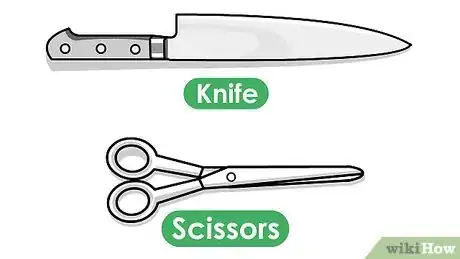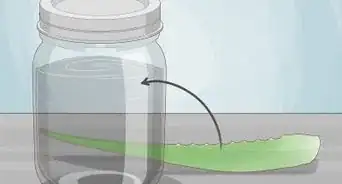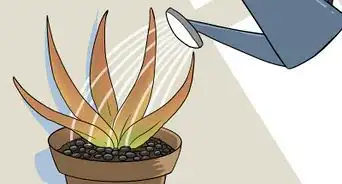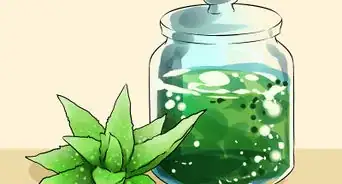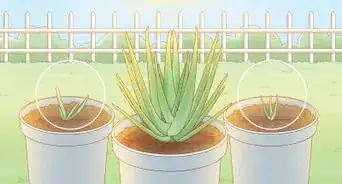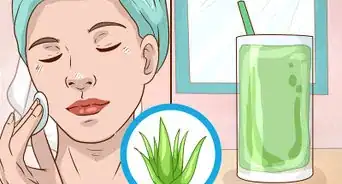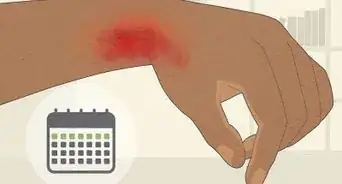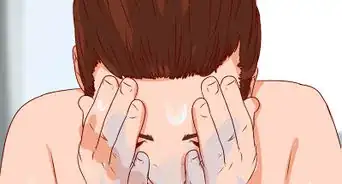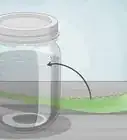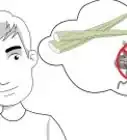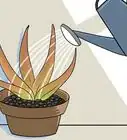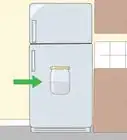This article was co-authored by Artemisia Nursery. Artemisia Nursery is a retail plant nursery in Northeast Los Angeles specializing in California native plants. Artemisia Nursery is a worker-owned small business with plans to become a worker-owned cooperative. In addition to California native plants, Artemisia Nursery offers a selection of succulents, heirloom veggie and herb starts, house plants, pottery, and gardening tools and supplies. Drawing on the knowledge of the founders, Artemisia Nursery also offers consultations, designs, and installations.
There are 8 references cited in this article, which can be found at the bottom of the page.
wikiHow marks an article as reader-approved once it receives enough positive feedback. This article received 21 testimonials and 90% of readers who voted found it helpful, earning it our reader-approved status.
This article has been viewed 995,173 times.
When healthy, aloe vera plants grow abundantly, forming new leaves, blossoms, and even new plants. Because of this, these plants require frequent attention. While an aloe plant requires more delicate trimming than other plants, following pruning methods will help you maintain your plant. By removing damaged and excess parts, you can promote health and growth in your plant and make it a proud part of your room.
Steps
Pruning the Visible Parts
-
1Get a cutting utensil. You’ll need something that can cut through small leaf stems and roots, such as a knife from your kitchen. Scissors can also be used, and if you’ve let a big plant go for a while, you many need shears to tame it.
- Sterilize kitchen knives before using them on your plant. You can do this by rubbing alcohol on the blade, and letting it dry.
-
2Trim damaged leaves. Tackle the bad leaves first. Carefully move the branches and leaves if you have to in order to find any leaves that are dried, brown, or dead. Unhealthy leaves that are highly discolored can also be removed. Use your knife or scissors to cut them at the stem.[1]
- Be gentle as you do this so that you do not accidentally break healthy leaves.
- Pests or disease on these leaves can infect the plant, so these leaves must be removed.
- Poor lighting, too little water, or too much water are causes for dying leaves.
- Aesthetically, it's best to harvest a whole leaf at a time, rather than cutting it in half.[2]
Advertisement -
3Cut excess outer leaves. Use your knife or shears to remove enough healthy leaves to make the plant fit in the pot. Bring the cutting tool to the base of the stem and slice through cleanly. These leaves are the oldest and contain the most aloe vera gel.[3]
- The gel has many medicinal purposes. If you want to use these leaves, cut the thorny edges on the leaves and store the leaves in the refrigerator until you want to extract the gel.
- Avoid cutting leaves closest to the plant's main stem. These leaves are young and are needed to replace the old leaves.
- Typically, an aloe vera plant will shed its lower leaves over time anyway, so these are the ideal leaves to trim when you want to prune your plant.[4]
-
4Remove old stems and blossoms. Cut these at the stem the same way you cut leaves. Once the flowers on the plant blossom, they soon drop seeds. While they die, they use nutrients that the plant could be putting towards new, healthy leaves. Since flowers rarely occur on aloe grown as a houseplant, if you grow your aloe vera indoors, you will likely not have to deal with blossoms.[5]
- Dead flowers attract bugs and can drop into the plant’s pot, absorbing water and creating a mess.
Clearing the Soil
-
1Remove suckers. Also called pups, suckers are offshoot plants. These new growths take energy away from your plant and crowd the pot. Most of the time, you can pull the shoots up out of the dirt with no harm to the plants. Use your cutting tool to cut the shoot off of your plant.[6]
- Some suckers may get buried and tangled under the soil, so you’ll have to take the plant out of the pot, carefully remove the dirt from the root ball, and untangle the roots.
- If you'd like, you can plant the pups in their own containers to grow them into a whole new plant.[7]
-
2Remove the plant from its pot. Make sure the soil is slightly damp before you remove the plant; this will help prevent damage to the roots. Gently hold the stem of the plant as you tilt the pot to the side. The plant should come out if you pull on it. If it doesn’t, try squeezing the pot or tapping it against a solid surface. Deal with any suckers you couldn’t get before.[8]
-
3Prune the roots. If you need to repot the plant, you may need to do this. First, shake the dirt off the plant. Trim the long root and remove some side roots. The amount that you leave should be enough to take up about 2/3 of its new pot. This makes the aloe vera easier to transport but also allows it to regrow a stronger root system in new soil. Water lightly until the plant has adjusted.[9]
- Let the plant air out for a day after pruning the roots. This will let any cuts on the roots heal into callouses and prevent long-term damage to the plant.
- Look out for root rot. Find any damaged areas and slice them off, being careful not to damage the healthy root. Sprinkle powdered sulfur or charcoal on the pruned areas if you can.[10]
Expert Q&A
-
QuestionMy plant was only watered for every 6 months. Now, I have started watering it every 2 weeks of when it needs it. It has green growing out of the brown. What should I do? Should I cut off both the green and the brown parts?
 Katie GohmannKatherine Gohmann is a Professional Gardener in Texas. She has been a home gardener and professional gardener since 2008.
Katie GohmannKatherine Gohmann is a Professional Gardener in Texas. She has been a home gardener and professional gardener since 2008.
Professional Gardener Sounds like your plant died back to the roots, and is now growing again. Your watering schedule sounds about right- I water my aloe every few weeks. Go ahead and remove the brown parts- they aren't coming back. Leave anything that's green. Hopefully your aloe will regrow itself completely!
Sounds like your plant died back to the roots, and is now growing again. Your watering schedule sounds about right- I water my aloe every few weeks. Go ahead and remove the brown parts- they aren't coming back. Leave anything that's green. Hopefully your aloe will regrow itself completely! -
QuestionDo the leaves grow back once I cut them? Or do I have to repot it to grow an entirely different plant?
 Katie GohmannKatherine Gohmann is a Professional Gardener in Texas. She has been a home gardener and professional gardener since 2008.
Katie GohmannKatherine Gohmann is a Professional Gardener in Texas. She has been a home gardener and professional gardener since 2008.
Professional Gardener The leaves that you cut off won't grow back, but the plant will replace them by growing new ones at the top. Your plant should be fine if you cut off a leaf now and then.
The leaves that you cut off won't grow back, but the plant will replace them by growing new ones at the top. Your plant should be fine if you cut off a leaf now and then. -
QuestionMy aloe vera plant has a broken leaf. Should I cut the whole leaf off?
 Katie GohmannKatherine Gohmann is a Professional Gardener in Texas. She has been a home gardener and professional gardener since 2008.
Katie GohmannKatherine Gohmann is a Professional Gardener in Texas. She has been a home gardener and professional gardener since 2008.
Professional Gardener It's up to you whether or not to cut the leaf - the plant itself should be fine either way.
It's up to you whether or not to cut the leaf - the plant itself should be fine either way.
References
- ↑ https://tipnut.com/aloe-vera-plant-growing-usage-tips/
- ↑ Artemisia Nursery. Plant Nursery & Garden Shop. Expert Interview. 7 August 2020.
- ↑ http://www.thegardenpages.com/aloe_vera.html
- ↑ Artemisia Nursery. Plant Nursery & Garden Shop. Expert Interview. 7 August 2020.
- ↑ http://www.aloeplant.info/trim-an-aloe-plant/
- ↑ http://www.aloeplant.info/how-to-propagate-your-aloe-vera-plant/
- ↑ Artemisia Nursery. Plant Nursery & Garden Shop. Expert Interview. 7 August 2020.
- ↑ http://www.houseplantsexpert.com/propagating-an-aloe-vera-plant-and-repotting.html
- ↑ http://www.aloeplant.info/aloe-root-care/
About This Article
If you need to trim an overgrown aloe vera plant, rub alcohol on a sharp knife or pair of scissors to sterilize the blades. Remove damaged, discolored, or dried leaves first, cutting close to the stem. Next, cut away excess outer leaves until the plant fits in the pot, then cut away any old stems and blossoms from the center of the plant. If you want to save the leaves to use them for their medicinal benefits, trim away the thorny edges and store the leaves in the refrigerator until you want to extract the gel. To learn more from our Horticulturist co-author, like how to prune the roots on your aloe vera, keep reading the article!
